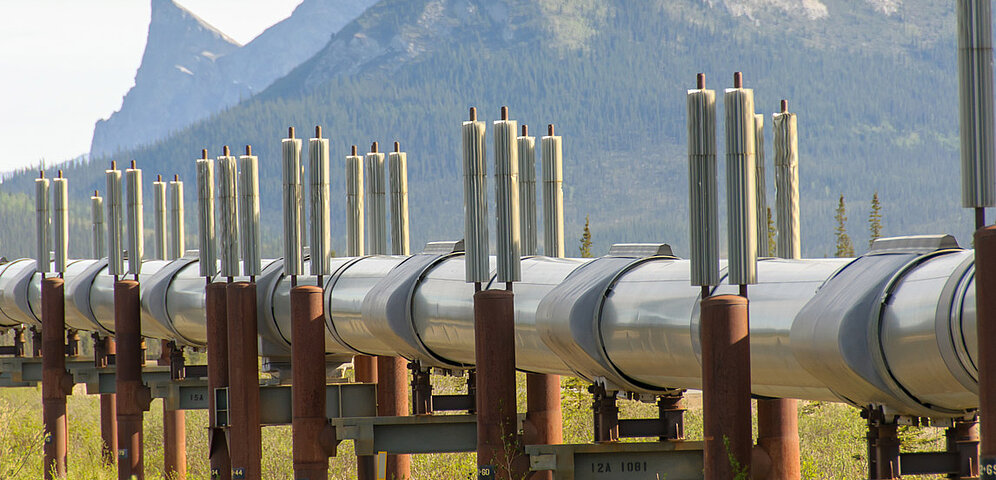Making Pipelines Greener
How KNF pumps help detect leaks harmful to the environment

With climate and environmental concerns rising globally, there is an ongoing search for new energy sources all over the world. Renewable resources exploited by solar panels, wind turbines or hydroelectric power plants are promising solutions for the future. Presently, however, fossil fuels are still needed to satisfy the growing global energy demand. Natural gas, in particular, plays a crucial role in this area as it delivers cleaner energy than coal and oil. In this field, KNF pumps help detect leaks to make using gas as sustainable as possible.
Environmental concerns have gained global attention and will very likely remain an important, if not the most important issue worldwide for years to come. International efforts like the Paris Agreement aim at reducing greenhouse emissions and try to keep the increase of the global average temperature well below 2° C. In addition, political movements like Fridays for Future draw attention to the most pressing environmental issues. Simultaneously, global energy consumption is at an all-time high with no decrease in sight as developing countries’ energy demand increases with their progressing development.
Renewable energy requires profound transformation
Currently, the world’s energy demand is satisfied mainly by oil, gas, and coal. Even though this is widely considered a problem, a quick shift towards entirely carbon free energy sources is not possible. The numbers illustrating this issue are staggering: To meet the current global energy consumption, 3,995,434 wind turbines would be required. There are currently just about 340,000 wind turbines in use. Looking at solar power reveals a similar problem: It would take about 51.4 billion 350W solar panels to power the world. These panels would cover about 115,600 square miles (300,000 square kilometers) – roughly the size of the entire country of Italy or the U.S. State of Arizona.
Natural gas – a much needed bridge technology
Compared to oil and coal, natural gas is a much cleaner energy source. Using natural gas rather than coal for energy production generates fewer emissions of nearly all types of air pollutants including carbon dioxide. Dr Fatih Birol, Executive Director at the International Energy Agency puts it this way, “Natural gas is one of the mainstays of global energy. Where it replaces more polluting fuels, it improves air quality and limits emissions of carbon dioxide” (IEA, 2019). With the lead time needed for a shift towards renewable energies and a growing global energy demand in mind, using natural gas as a bridge technology until sustainable alternatives are widely available appears as a good option.
Methane worse than CO2
When handling natural gas, it is imperative that as little as possible leaks into the atmosphere. Normally, natural gas contains more than 90 % methane. Over time methane found in critical layers of the atmosphere begins to degrade. UV wavelengths of energy from the sun, especially in and around the 254nm range create the hydroxyl radical OH and Oxygen from water vapor. The OH hydroxyl ion “scrubs” methane from the atmosphere. But since the time required to clean methane varies with respect to other greenhouse gases, the overall effect is studied over time.
For a period of 20 years, methane is shown to have a “Global Warming Potential” of 72 times more than CO2. Over a period of 100 years, it is shown to be 25 times more harmful to the atmosphere than CO2 (Forster et al., 2007). Currently, approximately 17% of all identified greenhouse emissions are comprised of methane (Ritchie & Roser, 2020). Of these 17%, roughly one quarter is caused by the oil and gas industry (Global Methane Initiative, n.d.). Transporting gas to processing plants, power plants and end consumers, pipelines span around the globe. In the U.S. alone, 305,000 miles (490,850 kilometers) of pipelines are used for gas transportation (EIA, n.d.). Here, every compressor, valve, junction, or weld carries a risk of leaking.
That is why detecting and sealing leaks is crucial to preserve the sustainability potential of natural gas. For this detection process, pumps by KNF play a discreet but important role.
How KNF pumps help detect leaks
Pipeline leaks not only emit natural gas into the atmosphere, but also allow ambient air to enter the pipeline causing an increase in oxygen which can cause premature pipe failure in other parts of the pipeline. Therefore, leaks can be detected by measuring gas purity at various points along the pipeline. If the natural gas suddenly contains more oxygen at a certain sample point, one or several leaks must exist at some point upstream. For the purpose of verification, a pump such as from the KNF NMP 830 series intermittently take a sample by drawing a vacuum against the flow of gas in the pipeline. The sample is then delivered to a sensor where it is analyzed. If the oxygen level measured exceeds a predetermined threshold, the unit alerts a central monitoring station. The technical requirements for this kind of pump are high: It must not contaminate the gas sample and as measuring points are often located in remote areas, the pump has to be maintenance-free and needs to offer a long service life.
We are aware of the high demands on applications used in the oil and gas industry. Decades of cooperation with customers in this industry enable us to individually adapt our pump solutions to their specific requirements. We will also be happy to answer your questions and help you implement your specific application. Get in touch with one of our KNF experts for your project.
References
EIA. (n.d.). EIA - Natural Gas Pipeline Network - Transporting Natural Gas in the United States. Retrieved May 27, 2021 from www.eia.gov/naturalgas/archive/analysis_publications/ngpipeline/index.html
Forster, P., V. Ramaswamy, P. Artaxo, T. Berntsen, R. Betts, D.W. Fahey, J. Haywood, J. Lean, D.C. Lowe, G. Myhre, J. Nganga, R. Prinn, G. Raga, M. Schulz & R. Van Dorland (2007). Changes in Atmospheric Constituents and in Radiative Forcing. In: Climate Change 2007: The Physical Science Basis. Contribution of Working Group I to the Fourth Assessment Report of the Intergovernmental Panel on Climate Change [Solomon, S., D. Qin, M. Manning, Z. Chen, M. Marquis, K.B. Averyt, M.Tignor & H.L. Miller (eds.)]. Cambridge University Press, Cambridge, United Kingdom and New York, NY, USA.
Global Methane Initiative. (n.d.). Global Methane Emissions and Mitigation Opportunities. Retrieved May 27, 2021 from www.globalmethane.org/documents/gmi-mitigation-factsheet.pdf
IEA. (2019). The Role of Gas in Today’s Energy Transitions – Analysis. Retrieved May 27, 2021 from www.iea.org/reports/the-role-of-gas-in-todays-energy-transitions
Ritchie, H. & Roser, M. (2020). Greenhouse gas emissions. Our World in Data. Retrieved May 27, 2021 from ourworldindata.org/greenhouse-gas-emissions



